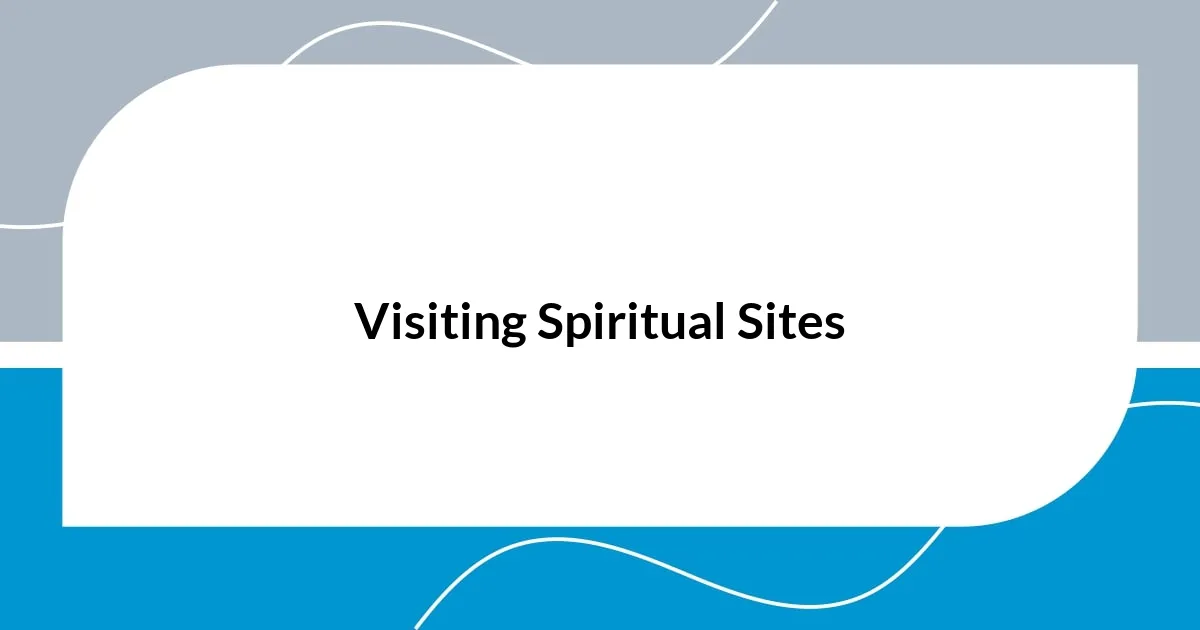Key takeaways:
- Spiritual landmarks evoke personal transformation and reflection, serving as touchstones in the search for deeper understanding.
- Defining one’s spiritual journey involves introspection and identifying core values that guide personal exploration.
- Researching spiritual locations enhances the experience through understanding their history and engaging with local communities.
- Integrating insights from spiritual experiences into daily life fosters mindfulness and connection, enriching everyday moments.

Understanding Spiritual Landmarks
Spiritual landmarks are more than just physical locations; they embody the essence of our journeys toward understanding and connection. I remember standing atop a mountain during a retreat, the air thick with intention. At that moment, I felt a profound shift within me, as if the landscape held ancient wisdom waiting to be unveiled.
These landmarks often serve as mirrors, reflecting our inner landscapes. Have you ever found yourself visiting a place that stirs something deep within? I once wandered into a time-worn chapel, its calm presence washing over me like a gentle wave. It was there, surrounded by the whispers of history, that I realized how these sites can catalyze transformation and inspire personal reflection.
When we seek out spiritual landmarks, we’re essentially searching for touchstones that can help us navigate our own paths. Think about it: how often do we feel lost or disconnected? For me, visiting a sacred grove brought about clarity during a tumultuous period in my life. It’s fascinating how these sites can resonate with our stories, reminding us that we’re part of something much larger.

Defining Your Spiritual Journey
Defining your spiritual journey requires introspection and an understanding of what truly resonates with you. I often find that clarity unfolds when we spend time reflecting on our past experiences. For instance, after participating in a series of guided meditations, I realized that my spiritual exploration was not just about seeking out locations but about uncovering deeper layers of my own identity.
Each person’s journey is unique, shaped by personal experiences and beliefs. I once visited a labyrinth that symbolized the winding path of life. As I made my way through its twists and turns, I felt the burdens of my unease dissipate, underscoring the importance of allowing oneself to embrace uncertainty on this path. It was a reminder that the journey itself often holds as much significance as the destination.
While navigating your spiritual journey, consider the questions that arise within you. I frequently ask myself what core values guide my exploration. When visiting a place significant to my history, I was struck by memories that sparked a renewed commitment toward authenticity in my life. These landmarks aren’t just destinations; they’re metaphors for the ongoing quest for deeper understanding.
| Element | Description |
|---|---|
| Introspection | Reflecting on experiences to gain clarity. |
| Unique Journeys | Personal experiences shape spiritual paths. |
| Core Values | Identifying guiding principles helps focus purpose. |

Researching Spiritual Locations
When researching spiritual locations, I often feel drawn to explore not just the destinations themselves, but the stories behind them. My own experience at a sacred site in the foothills of the Himalayas opened my eyes to the rich tapestry of beliefs woven throughout the ages. The tales shared by local guides breathed life into the stones, making the experience not just a visit, but a journey through the cultural and spiritual fabric of the region.
Here are a few strategies I’ve found useful when researching spiritual landmarks:
- Utilize Online Resources: Websites, blogs, and forums dedicated to spirituality can provide insights and recommendations.
- Read Books and Articles: Literature often delves into the historical and cultural aspects of locations, enriching your understanding.
- Join Local Spiritual Groups: Engaging with others on similar quests can lead to shared experiences and new discoveries.
- Seek Personal Testimonials: Hearing about others’ experiences can spark curiosity and help you connect on a deeper level.
Every search for a spiritual site feels like peeling back layers of history. In my experience, planning a trip to a serene monastery taught me the value of preparation. Not only did I search for details about the location, but I also looked into the rituals practiced there. This layered approach enhances the connection I feel, often leading to unexpected moments of enlightenment during my visits.

Connecting with Local Communities
Building relationships with local communities can significantly deepen your spiritual journey. I remember attending a small gathering at a community center in a quiet town where I found genuine warmth and wisdom from the locals. Learning about their traditions and spiritual practices created a sense of connection that surpassed mere observation; it felt like stepping into their lives for a moment.
Have you ever considered how much local stories can enrich your experience? When I participated in a ceremonial gathering led by a native elder, I was struck by the power of community storytelling. Each shared experience not only illuminated the spiritual significance of the site but also connected me with the land and people in a profound way. I walked away feeling a part of something larger than myself.
Engaging with local communities doesn’t have to be daunting. I often begin with small conversations—perhaps chatting with a shopkeeper or joining a local meditation group. These little exchanges have led me to unexpected gems, from secluded spots for reflection to insightful discussions that linger long after the visit ends. Finding ways to connect creates a tapestry of experiences that enriches my spiritual exploration.

Visiting Spiritual Sites
Visiting spiritual sites can be a deeply transformative experience. I recall the moment I stepped onto the ancient grounds of a well-known temple. The air was fragrant with incense, and I could feel a sense of reverence enveloping the space, sparking a feeling of belonging. It’s incredible how specific sights, sounds, and smells can awaken a profound inner peace and reflection.
As I wandered through the temple’s quiet corridors, I took my time to observe the intricate carvings and listen to the whispers of fellow seekers. It struck me that each person visiting brought their own story, their own quest for connection to something greater. Have you ever noticed how the energy shifts in such places? Sometimes, it’s not just about what we see; it’s about the shared silence that embraces us all, making us realize we’re part of a collective search for meaning.
In my travels, I’ve also learned the importance of timing when visiting these sacred places. There was one occasion where I arrived at a sacred spot just before dawn. As the sun rose, the golden light illuminated the landscape, creating a breathtaking spectacle that felt like nature itself was offering a blessing. That stillness of early morning, filled with anticipation, was a reminder that the most profound experiences often occur when we allow ourselves the space to simply be present.

Reflecting on Personal Experiences
Reflecting on personal experiences has a unique way of shaping our spiritual journeys. I often find that the moments that stand out to me are those in which I felt an internal shift. For instance, during a solitary hike to a hidden waterfall, the sound of rushing water seemed to wash away my worries, leaving me relaxed and open to introspection. Have you ever found solace in nature like this?
Sometimes, it’s the unexpected moments that resonate the most. I remember sitting in a sun-drenched meadow one afternoon, completely still, when a butterfly landed on my hand. That simple encounter sparked a wave of gratitude, reminding me of the subtle connections in life that often go unnoticed. Such experiences reinforce my belief that spirituality isn’t solely found in grand gestures; it can also flourish in the quiet, seemingly mundane instances.
There are times I’ve journaled after such experiences, capturing the emotions and thoughts that arose. Reflecting on those entries later reveals patterns and insights that inform my spiritual path. When I reread my notes, it’s like having a conversation with my past self. What lessons have you discovered in your reflections? I’ve learned that the act of revisiting these moments often leads to deeper understanding and growth.

Integrating Insights into Daily Life
Integrating insights from spiritual landmarks into daily life requires intentional practice. I remember coming home from a particularly enlightening visit to a sacred site, feeling inspired to create a small altar in my living room. Each item I placed there—a crystal, a candle, a piece of nature—served as a tangible reminder of the peace I had experienced. Have you ever found ways to bring that sense of serenity into your everyday environment?
Sometimes, I find that the lessons learned from these experiences manifest in subtle ways. After an encounter with a wise monk, I began embracing the art of mindful breathing during everyday tasks, such as washing dishes or waiting in line. It was a surprising shift; suddenly, mundane moments transformed into opportunities for connection and calm. How often do we overlook these small practices that can brighten our day?
I’ve also discovered that sharing my experiences with friends can enhance the integration process. One afternoon, I hosted a gathering where we each brought items or stories from our spiritual journeys. The conversations that flowed felt rich and meaningful, and I left feeling re-energized and connected. Isn’t it amazing how collective sharing can deepen our individual insights? By weaving these threads into my daily life, I am continually reminded of the profound connections around me.